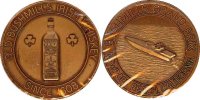


Tokens used sometime between 1824-1831. Possibly bought & exchanged for spent grain, in a similar fashion to those issued by Stein Brown (see below).
The NSI Bulletin No. 28 has published a listing of these. This suggests the the number of times "IL" has been stamped on the token represents the number of loads the token is worth. I doubt this - it would be simpler to just give one token per load - presumably a cartload. The paper split the various types up as follows;
| Group A | as illustrated above ie "IL" and "FB&Co" struck from 2 dies although one piece only has "FB&Co" |
| Group B | struck with only the "IL" - between 1 and 4 times - 1-4 loads? Possibly after the breakup (1831) of the Fallon and Brett partnership? |
| Group C | "IL" 1, 2 or 4 times on the back of what is believed to have been a brass thermometer scale (c1875) from Yeates & Son Dublin |
| Group D | "IL" (formed by 3 strikes of a single line) 1 to 5 times |
In the late 1980/early 90s, the dealer C.J.Denton advertised a group of ten tokens in copper, brass, pewter which were square, round & triangular & stamped IL (one load?) and FB&C (Fallon Brett & Co.). The sizes ranged from 20 to 50mm. He stated they were a Kilbeggan distillery's tally token.
Some years later, S Byrne had a large number of similar tokens, some of which were crudely made from a brass ruler (?) (later identified in the NSI bulletin). I bought three and the remainder were later listed in Whytes auction catalogue. In 1994 I passed through Kilbeggan & chanced upon Locke's Distillery Museum and was pleasantly surprised to see similarly marked tokens on display. Others were of better quality and perhaps a later issue.
My letter to Locke's Museum for information on the pieces was kindly answered by Amanda Pedlow, Tourist Manager at Locke's, with rubbings of the 10 tokens in their collection. The letter was accompanied by a four page photocopied extract (pp 24-27) of the book "Locke's Distillery - A History" written by Andrew Bielenberg and published by The Lilliput Press (Dub 1993). This showed how the number of distilleries jumped in the 1820s and 30's as a result of the duty being reduced from 5 shillings and 7 1/2d to 2 shillings and 4 3/4d (presumably per gallon) to try and combat the illegal poteen;
| 1820 | 1821 | 1822 | 1823 | 1824 | 1825 | 1826 | 1827 | 1828 | 1829 |
|---|---|---|---|---|---|---|---|---|---|
| - | 32 | - | - | - | - | - | 82 | 81 | 80 |
| 1830 | 1831 | 1832 | 1833 | 1834 | 1835 | 1836 | 1837 | 1838 | 1839 |
| 79 | 81 | 84 | 82 | 89 | 93 | 90 | 90 | 87 | 89 |
| 1840 | 1841 | 1842 | 1843 | 1844 | 1845 | 1846 | 1847 | 1848 | 1849 |
| 86 | 75 | 70 | 64 | - | - | - | - | - | - |
The quantity produced from all distilleries rose from 3,627,332 in 1821 to a peak of 11,894,169 gallons of proof spirit in 1835. It had reduced to 5,550,706 by 1843. The extract went on to describe how George Codd's Brusna Distillery was revived and after his death in 1823, the building was let to John Fallon, a Tullamore tobacconist with financial help from his brother Charles (Fallon) from Mullingar. After using the building for brewing, it was once again used for distilling and in February 1824, he joined with Patrick Brett of Clara, and Henry Gower of Dublin. Each invested £500 and the company started trading as 'John Fallon, Patrick Brett and Co.' During the 1825-6 season, FB&Co produced 29,554 gallons and its reputation grew. The partnership was dissolved in 1831 due to Fallon's financial difficulties, but the distillery continued with Brett and others.
Note: Lewis (see Westport below) notes that by 1837, the reduction in duty mentioned above caused at least one brewery to have a slump in sales!
From 1868 Mary Anne Locke ran the distillery, after her husband John died, up to c.1880. She increased output by investing in improvements and expansion. Her two sons, John Edward and James Harvey became increasingly involved in the distillery and took over the running in the 1880s (and are mentioned in the Barnard account below). A second period of female rule for Locke's began after James Harvey's death in 1927. Mary, the wife of John Edward (who died in 1920) became director, although her involvement with the distillery was minimal. When she died in 1943, her two daughters, Mary Evelyn and Florence Emily, took on a more active role in the board of directors, with Mary taking the chair and Florence playing a more minor role. Neither of them was much involved in the daily running of the distillery. In 1947 the sisters decided to sell the distillery. The syndicate they sold the distillery turned out to be criminals under false passports who had no intentions of running the distillery but were interested in the large amounts of Locke's maturing stocks. The whole thing snowballed into 'The Locke's Scandal' which eventually even played a role in the fall of the government. The scandal, bad management, under-investment and economic circumstances all contributed to distilling to cease at Locke's in 1953.
The following was found on the www.
FACTS ABOUT LOCKE'S DISTILLERY MUSEUM
National Winner - AIB Better Ireland Awards 1997. We are proud to be the national winners of the 1997 AIB Better Ireland Awards in the heritage section. This reflects the work done by the community of Kilbeggan over the past 15 years in restoring and presenting the museum. Locke's Distillery is the only small pot still whiskey distillery remaining in Ireland, the only examples of what used to be a widespread Irish industry. Locke's Distillery was licensed in 1757 and produced whiskey for over 200 years, closing in 1953. In 1982 the local community began restoring the distillery and have re-opened it as a museum. The museum is open seven days a week and there is a choice of a guided or self-guided tour. The guided tour takes about 40 minutes and shows the ancient process of whiskey making, from the mill stones, to the mash tuns, underbacks, fermentation vats, can pit stills to the casking of the final product. The two sources of power, the steam engine and the water wheel are always of great interest. The tour is complemented by the tales and stories gathered from the workers from the distillery. Over 85% of the original distillery machinery remains intact and restoration work is ongoing. In July 1997, the machinery turned again for the first time since closure. The drive shaft, pulleys and pumps are all working on a daily basis. An exhibition in the front grain loft was opened by Her Excellency, Mary McAleese, President of Ireland on June 17th 1998. It presents a large part of the collection of distillery artefacts. This new addition greatly enhances the visits. The museum is complemented by the Locke's Pantry Coffee Shop which serves both individuals and group business. The menu specialises in home baked fresh foods. Kilbeggan is a traditional North-South, East-West crossroads, making it a perfect stop-over for your journey. The guided tour and snack/meal in the Pantry is the ideal break.
The following details are from the book Whisky Distilleries of the United Kingdom, by Alfred Barnard, published by Harper's Weekly Gazette in 1887.
BRUSNA DISTILLERY,
Kilbeggan
Proprietors, John Locke & Co.
The Brusna Distillery is said to be the oldest in Ireland, having been founded in the year 1750. It covers nearly five acres of ground, and the adjoining lands extending for half-a-mile on the river side, are also owned by John Edward and James H. Locke. Both these young men are practical distillers, and it is owing to their enterprise that the business has increased and the output been more than doubled during the last ten years. To do this they have, from time to time, made considerable additions to the old work - adding new machinery and modern appliances, still retaining, where practicable, the ancient ones, so as not to interfere with their old-fashioned Pot Stills, Mashing Vessels, and method of drying malt. The establishment, which is entirely enclosed, has a frontage to the main road of 150 feet, and entered by an archway, the clerks' and Excise offices being built therein. It stands on the banks of the river from which it derives its name, and the water for both driving and mashing comes from that stream. There is such an abundant and continuous supply, that at the time of our visit Messrs. Locke & Co. were arranging to use it for an electric light power in the premises. Having plenty of time, we first rambled through the old place with the partners, and afterwards commenced our duties by inspecting the Maltings, which are all built opposite the Distillery proper. They are light and well-ventilated buildings of five floors, capable of holding 10,000 barrels of corn. When we were there the yard at the back was crowded with farmers' carts, laden with barley put up in home-made flax sacks of a primitive shape and nearly 6 feet in length. After inspection by the corn-buyer, the barley is hoisted to the different floors and there spread out to a depth of 3 feet, from whence, as required, it is made to fall through traps on to the Malting Floors below, each of which possesses a stone Steep. The firm make all their own malt, being of opinion that they can manufacture a finer quality than can be purchased.
Seventy men are employed on the premises, the aged and infirm always being pensioned off or assisted. The make is "Old Pot Still," and principally sold in Dublin, England, and the Colonies. It is both a self and a blending Whisky, and the annual output (1885-1886) was 157,200 gallons. The plant is, however, capable of making over 200,000 gallons. Messrs. Reidy and Byrne are the chief Excise officers.







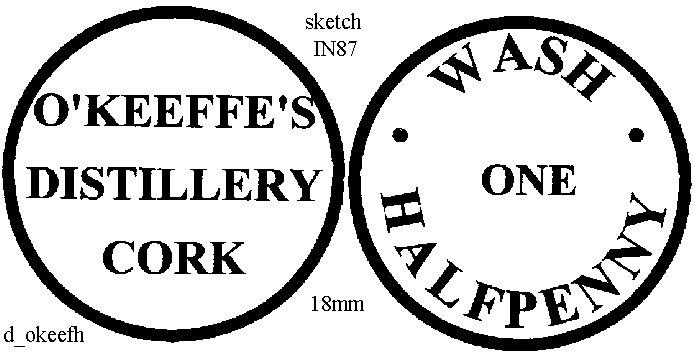


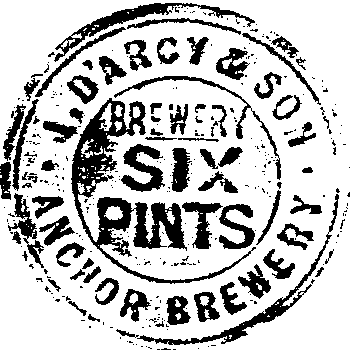

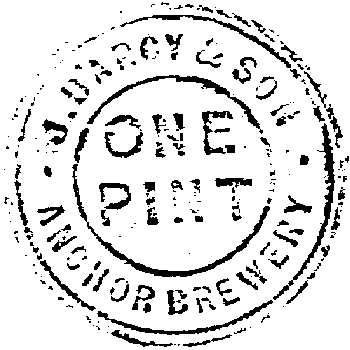

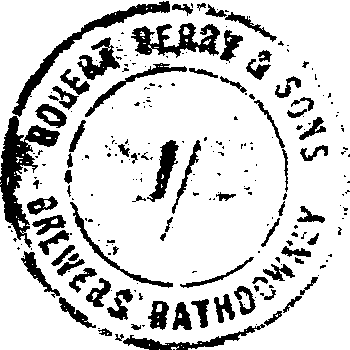
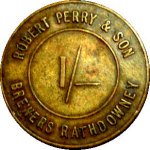
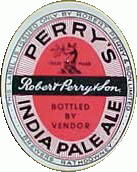 A Robert Perry & Son, Rathdowney India Pale Ale bottle label.
A Robert Perry & Son, Rathdowney India Pale Ale bottle label.

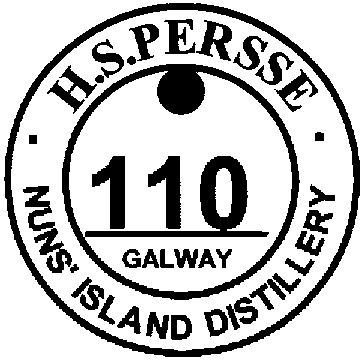


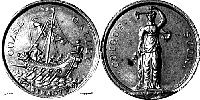 Note the galley is similar to the one on the Ouzel Galley piece, made by Parkes of Dublin and listed under Miscellaneous (Tickets & Passes). That piece has 3 rowers and 4 oars! This galley has 6 oars and 6 rowers.
Note the galley is similar to the one on the Ouzel Galley piece, made by Parkes of Dublin and listed under Miscellaneous (Tickets & Passes). That piece has 3 rowers and 4 oars! This galley has 6 oars and 6 rowers.
